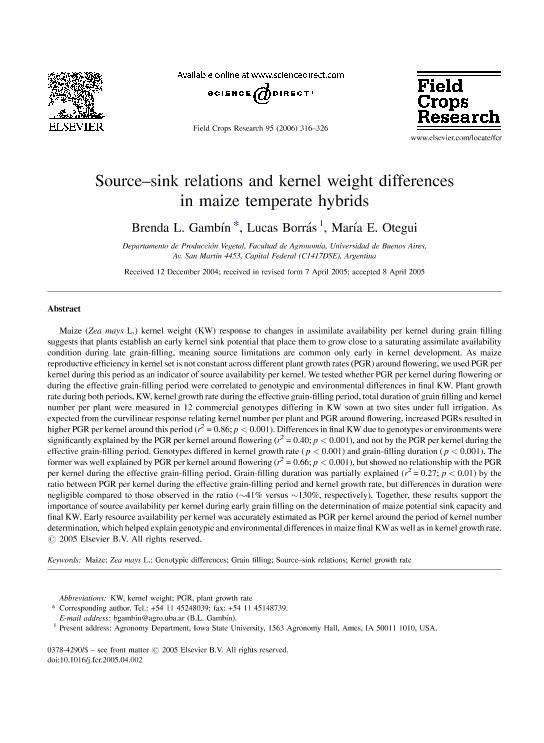Mostrar el registro sencillo del ítem
dc.contributor.author
Gambin, Brenda Laura

dc.contributor.author
Borras, Lucas

dc.contributor.author
Otegui, Maria Elena

dc.date.available
2022-02-16T18:11:18Z
dc.date.issued
2006-12
dc.identifier.citation
Gambin, Brenda Laura; Borras, Lucas; Otegui, Maria Elena; Source-sink relations and kernel weight differences in maize temperate hybrids; Elsevier Science; Field Crops Research; 95; 2-3; 12-2006; 316-326
dc.identifier.issn
0378-4290
dc.identifier.uri
http://hdl.handle.net/11336/152130
dc.description.abstract
Maize (Zea mays L.) kernel weight (KW) response to changes in assimilate availability per kernel during grain filling suggests that plants establish an early kernel sink potential that place them to grow close to a saturating assimilate availability condition during late grain-filling, meaning source limitations are common only early in kernel development. As maize reproductive efficiency in kernel set is not constant across different plant growth rates (PGR) around flowering, we used PGR per kernel during this period as an indicator of source availability per kernel. We tested whether PGR per kernel during flowering or during the effective grain-filling period were correlated to genotypic and environmental differences in final KW. Plant growth rate during both periods, KW, kernel growth rate during the effective grain-filling period, total duration of grain filling and kernel number per plant were measured in 12 commercial genotypes differing in KW sown at two sites under full irrigation. As expected from the curvilinear response relating kernel number per plant and PGR around flowering, increased PGRs resulted in higher PGR per kernel around this period (r2 = 0.86; p < 0.001). Differences in final KW due to genotypes or environments were significantly explained by the PGR per kernel around flowering (r2 = 0.40; p < 0.001), and not by the PGR per kernel during the effective grain-filling period. Genotypes differed in kernel growth rate (p < 0.001) and grain-filling duration (p < 0.001). The former was well explained by PGR per kernel around flowering (r2 = 0.66; p < 0.001), but showed no relationship with the PGR per kernel during the effective grain-filling period. Grain-filling duration was partially explained (r2 = 0.27; p < 0.01) by the ratio between PGR per kernel during the effective grain-filling period and kernel growth rate, but differences in duration were negligible compared to those observed in the ratio (∼41% versus ∼130%, respectively). Together, these results support the importance of source availability per kernel during early grain filling on the determination of maize potential sink capacity and final KW. Early resource availability per kernel was accurately estimated as PGR per kernel around the period of kernel number determination, which helped explain genotypic and environmental differences in maize final KW as well as in kernel growth rate.
dc.format
application/pdf
dc.language.iso
eng
dc.publisher
Elsevier Science

dc.rights
info:eu-repo/semantics/openAccess
dc.rights.uri
https://creativecommons.org/licenses/by-nc-sa/2.5/ar/
dc.subject
GENOTYPIC DIFFERENCES
dc.subject
GRAIN FILLING
dc.subject
KERNEL GROWTH RATE
dc.subject
MAIZE
dc.subject
SOURCE-SINK RELATIONS
dc.subject
ZEA MAYS L.
dc.subject.classification
Agronomía, reproducción y protección de plantas

dc.subject.classification
Agricultura, Silvicultura y Pesca

dc.subject.classification
CIENCIAS AGRÍCOLAS

dc.title
Source-sink relations and kernel weight differences in maize temperate hybrids
dc.type
info:eu-repo/semantics/article
dc.type
info:ar-repo/semantics/artículo
dc.type
info:eu-repo/semantics/publishedVersion
dc.date.updated
2021-04-28T21:44:38Z
dc.journal.volume
95
dc.journal.number
2-3
dc.journal.pagination
316-326
dc.journal.pais
Países Bajos

dc.journal.ciudad
Amsterdam
dc.description.fil
Fil: Gambin, Brenda Laura. Universidad de Buenos Aires. Facultad de Agronomía. Departamento de Producción Vegetal; Argentina. Consejo Nacional de Investigaciones Científicas y Técnicas. Oficina de Coordinación Administrativa Parque Centenario; Argentina
dc.description.fil
Fil: Borras, Lucas. Iowa State University; Estados Unidos. Universidad de Buenos Aires. Facultad de Agronomía. Departamento de Producción Vegetal; Argentina. Consejo Nacional de Investigaciones Científicas y Técnicas. Oficina de Coordinación Administrativa Parque Centenario; Argentina
dc.description.fil
Fil: Otegui, Maria Elena. Universidad de Buenos Aires. Facultad de Agronomía. Departamento de Producción Vegetal; Argentina. Consejo Nacional de Investigaciones Científicas y Técnicas. Oficina de Coordinación Administrativa Parque Centenario; Argentina
dc.journal.title
Field Crops Research

dc.relation.alternativeid
info:eu-repo/semantics/altIdentifier/doi/http://dx.doi.org/10.1016/j.fcr.2005.04.00
dc.relation.alternativeid
info:eu-repo/semantics/altIdentifier/url/https://www.sciencedirect.com/science/article/abs/pii/S0378429005000766
Archivos asociados
